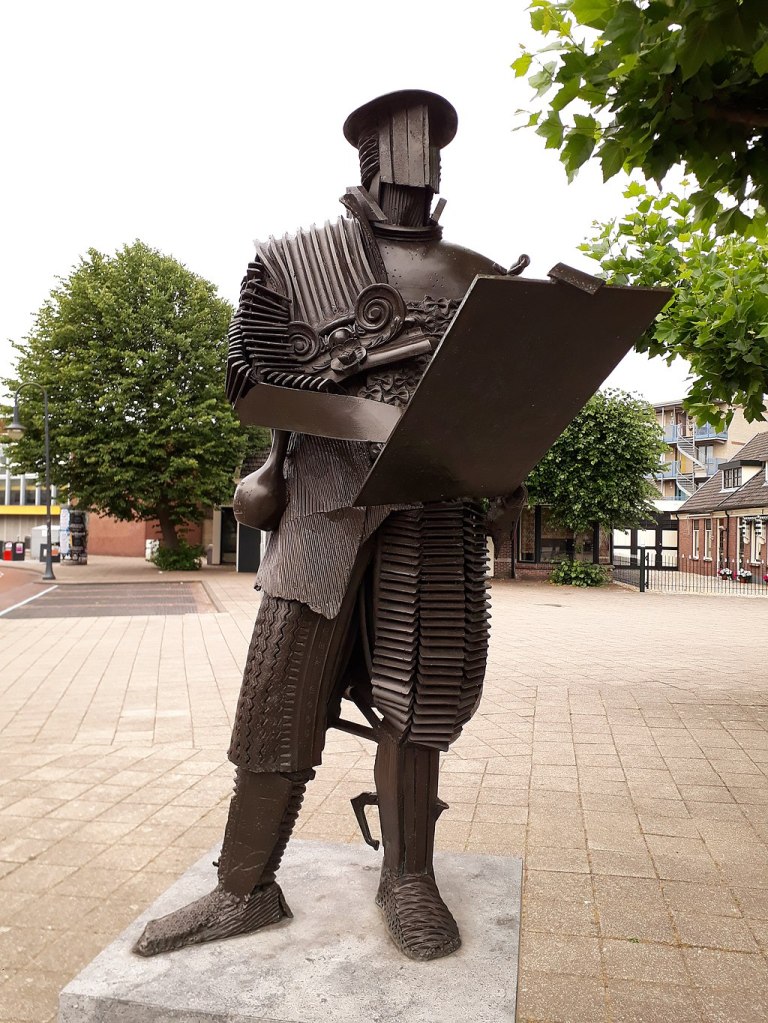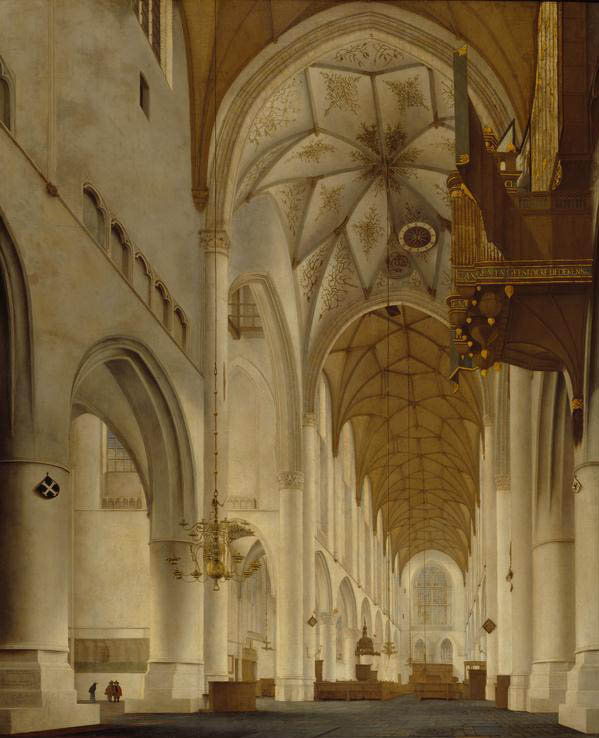(NB: This is a blog which I posted in 2020 and managed to delete while I was trying update it today … another example of my current and continuing brain fog.)
One of the many ways in which my day job changed during lockdown was that instead of spending a lot of time being polite to people on the phone and via emails, I was doing lots of proofreading, and as a result finding out all sorts of new Stuff.

Consider, for example, the life and works of Maarten van Heemskerck (both the Maarten and the Heemskerck can be variously spelled, but I’m going with the Rijksmuseum version). Born in Heemskerk, near Haarlem, in what is now North Holland, in the Netherlands, on 1 June 1498, the son of a farmer, Jacob Willemsz. van Veen, he spent most of his working life in Haarlem, but crucially to his career, and – arguably – to the course of northern European art, he was in Italy between the years 1532 and 1536.

The memorial statue to Heemskerck in his native town.
Karel van Mander (1548–1606), in his 1604 Schilder-Boek (‘Book on Painting’), states that Heemskerck was a pupil of first of Cornelis Willemsz. in Haarlem and then of Jan Lucasz. in Delft. (Unfortunately, no work by either of these painters is known to survive.) Back in Haarlem, in 1527 he began to work with Jan van Scorel (1495–1562), himself a pupil of Jan Gossaert (aka Jan Mabuse), as – presumably – more of an assistant than a pupil, since they were almost contemporaries. The attraction was that van Scorel had been in Italy between 1518 and 1524 (a period which included the brief papacy (1522–3) of Adriaan Florensz. Boeyens, Pope Adrian VI (so far the only Dutch heir of St Peter), whose portrait he painted.

Pope Adrian VI, by Jan van Scorel (Credit: Centraal Museum, Utrecht)
Van Scorel, as well as being the pope’s court painter, was also the curator of his collection of antiquities, and before arriving in Rome he had spent some time in Venice (one account says that he made a pilgrimage to the Holy Land at this period). After his patron’s death, he had returned north, became a priest and settled first in Haarlem and then in Utrecht, where he had a studio and specialised in altarpieces.
Portrait of Jan van Scorel by Antonis Mor (1560) (Credit: the Society of Antiquaries, London)
In May 1532, presumably eager to see what van Scorel had seen, Heemskerck set off for Rome, arriving in July that year. He seems to have spent a lot of time producing sketches of the ruins of ancient Rome and the newer buildings of the Renaissance. Many of these now survive in the Kupferstichkabinett in Berlin, and he clearly used then as the basis for paintings which had complex architectural backgrounds, almost in the manner of the later capriccio genre.
Heemskerck (1535), Panorama with the Abduction of Helen Amidst the Wonders of the Ancient World. Helen’s abduction is happening at the bottom. (Credit: the Walters Arts Museum, Baltimore)
He seems of have been among the earliest artists to sketch in a manner that could be easily followed by an engraver to make prints – of which the most famous is probably the sequence called ‘The Eight Wonders of the World’, produced by the Galle family (in-laws of the Moretus) of Haarlem and Antwerp in 1572. The ancient Seven Wonders (though the Hanging Gardens of Babylon are more prosaically called the Walls of Babylon) are followed by an Eighth, the Colosseum, an extraordinary a-chronological view.

The building is in ruins, with weeds growing from the cracked stonework, but a Roman (or possibly Visigothic???) emperor and his entourage marvel at it. At bottom left is a rather crude version of the she-wolf sucking Romulus and Remus, and above them a giant foot (sandalled, like the Piè di Marmo, rather than bare like the ones from the Colossus of Constantine). At the centre of the Colosseum itself is an intact statue of Jupiter, complete with thunderbolt and eagle; while in the arena there appears to be a combat between a lion and a unicorn, being cheered on by an almost ghostly crowd.
The British Museum has a complete sequence, once in the collection of Sir Hans Sloane:






This brings us back to the self-portrait. The picture was painted in 1553, nearly twenty years after his return from Italy, but in many ways it has an astonishing modernity. It plays tricks: it is a double self-portrait, since we must assume that the man seated at an easel and working away in the middle-ground is the artist himself. But then we notice that Heemskerck is also in fact standing not in the foreground of an historic landscape but outside of and in front of his picture: at the bottom, his tunic covers the corner of the ‘cartellino’ which bears his name and the date, which and is apparently pinned to the canvas in a trompe-l’oeil effect. He stands in front of his work and challenges your gaze: is he amused, or sardonic?
He is clearly daring you not to be impressed by his skill, and not without reason. He returned to Haarlem (probably via Mantua, where he would have seen Giulio Romano’s paintings in Palazzo Tè), and joined the local Guild of St Luke, becoming its deacon in 1554. He prospered as a painter of portraits and religious scenes, and continued to produce drawings to be engraved for prints. He is known to have married twice: his first wife died in childbirth,and his second brought money which would have confirmed his status in the town as an eminent citizen as well as an artist.
The prints made from his Italian sketches provided the middle classes of the Netherlands with a vision of Rome, and also influenced those artists of the next generation unable to make the journey themselves. His standing was such that when, in December 1572, Haarlem was under Spanish siege, he was given a safe-conduct to Amsterdam. He thus missed the collapse of the defence in July 1573, and the subsequent massacre of the garrison (though unlike Antwerp in 1576, the town was not pillaged, and its civilian population was allowed to live).
Heemskerck returned to Haarlem later in 1573, and died on 1 October 1574, aged seventy-six. By his will, he left money and land to support the orphanage of Haarlem; he also provided for money to be paid to any couple who stood on his grave-slab in St Bavo’s church (of which he had been sexton) during their wedding ceremony, there being, apparently, a local Catholic superstition that the deceased would benefit from the sacrament. The church is still St Bavo’s, or the Grote Kerk, but since 1578 Protestant rather than Catholic: its bare interior is the subject of one of Pieter Jansz. Saenredam’s paintings from 1648.

The reason I was trying to update the blog was to link it to the piece on Haarlem which I wrote last year and contains a photograph of Heemskerck’s grave: https://professorhedgehogsjournal.uk/2023/05/31/ive-been-to-haarlem/
Caroline





Thank you for this wonderful essay/report and the beautiful images.
With continuing respect and admiration,
Sandra Hyslop
LikeLike
Dear Sandra, thanks so much for these kind words!
All good wishes,
Caroline
LikeLike